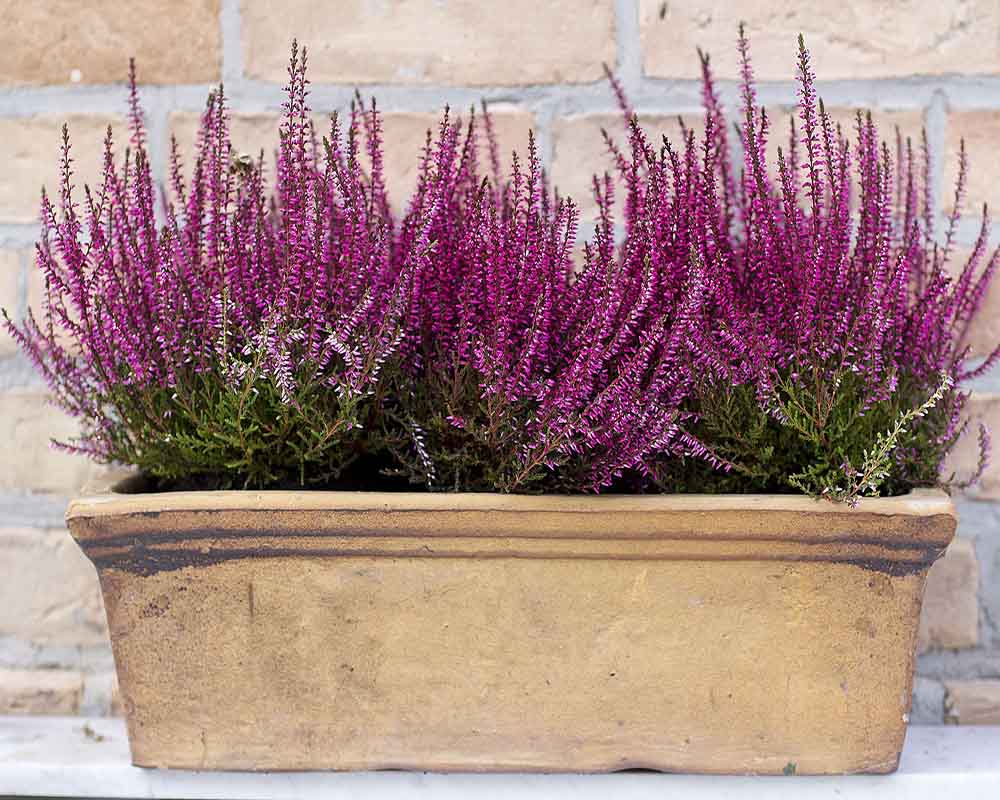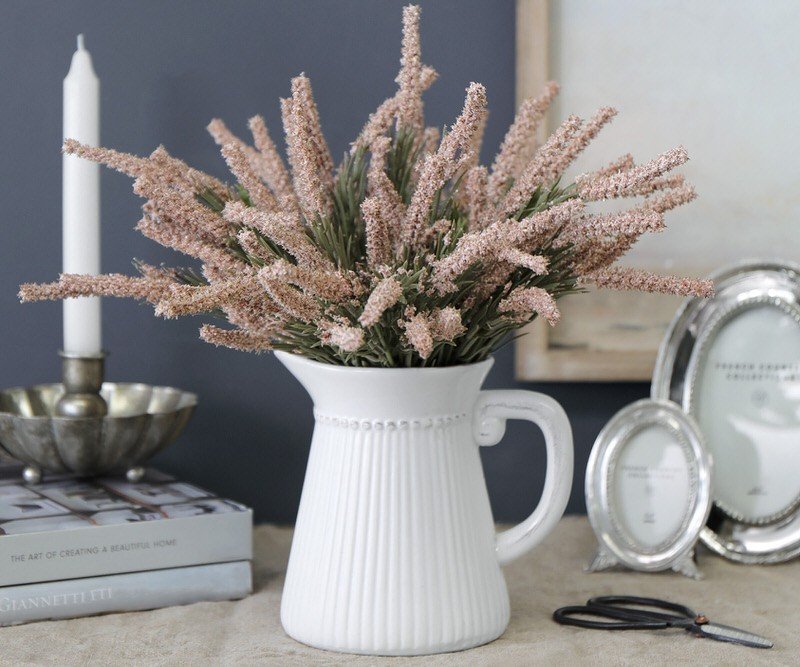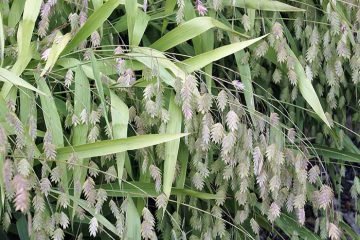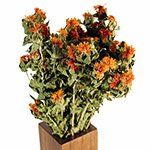Heather flower specifications
Heather flower
- Common Name : Heather, Scotch heather, Scottish heather
- Botanical Name : Calluna vulgaris
- Family : Ericaceae
- Plant Type : Broadleaf, evergreen shrub
- Mature Size : 24 in. tall; 24-36 in. wide
- Sun Exposure : Full, partial
- Soil Type : Sandy
- Bloom Time : Mid-summer, early fall
- Flower Color : Mauve, purple, white
- Native Area : Eurasia
Heather, commonly called Scotch Heather, is a small, woody perennial in the Ericaceae family. Its flowers, which bloom from mid-summer to early fall, are usually mauve, purple, or white. Its tiny (1/8 inch long), evergreen, scale-like leaves are valued just as much as its blooms. It is native to the bogs and moors of Scotland and other parts of Europe and is favored for the colorful flowers and foliage it adds to the landscape. The best time to plant it is in spring or early fall. Heather is slow-growing and averages about 18-inches in height.
read more : Everything about hydrangeas : How to Plant & care for Hydrangea

Heather Care
A clue to its proper care lies in its name immortalized in Scottish literature as the heath and moorlands. This habitat has acidic, well-drained, moist soil. These plants tolerate poor, rocky soil and even salt spray, making them good for coastal hillsides. Plants that grow in heathlands typically get by with fewer nutrients than the average plant. They rely more on watering and pruning than fertilizer.
A heather’s evergreen foliage changes and intensifies in hue during cooler temperatures. Height varies by cultivar. Shorter types are best-suited to be ground covers or planted in rock gardens; taller varieties can be grown in rows to form borders.
Warning
Heather is listed as invasive in parts of the United States, Canada, New Zealand, and Australia due to the crowding out of native species.
-
Light
Heather thrives best in full sun. In some areas, it welcomes afternoon shade.
-
Soil
Heather requires well-drained soil and does well in sandy soils or rocky terrain. It thrives in peaty, more acidic bogs and moorlands. It does not need fertile soil, it can thrive in poor soils and can tolerate salt spray.
read more : Everything about amaranth : How to Plant & care for them
-
Water
Water the plants faithfully when young. This plant requires one inch of water per week. Once established, heather has average water needs but will require more irrigation in warmer zones.
-
Temperature and Humidity
Heather likes cool, moist weather. Calluna is typically hardy in some areas, but may thrive with proper winter protection or snow cover. It cannot withstand high temperature and humidity.
-
Fertilizer
As long heather has some organic matter or peat moss in its soil, it does not need additional nutrients. Heather prefers acidic soil; you can give an acidifying nitrogen fertilizer made especially for acid-loving plants such as rhododendrons once a year in early spring. If you are going to give fertilizer, provide no more than one pound per 100 square feet and no later than August 1. Added any later, it will spur growth during the winter when the plant should be dormant. Excessive fertilization tends to cause leggy, spindly branches.
Types of Heather flower
The type of cultivar you choose depends on how you want the plant to function in your yard. Taller types form an oval mound, good for hedges; shorter types form a mat suitable for ground covers.
- Calluna vulgaris ‘Firefly’: 20 inches; flower color begins as chartreuse turns to lilac, foliage is reddish-brown in summer and finishes as brick-red in winter.
- Calluna vulgaris ‘Robert Chapman’: 8-18 inches high, greenish-yellow foliage in summer, changing to orange-red and reddish in winter. Rose-purple flowers in slender 20-25 cm long clusters in late summer.
- Calluna vulgaris ‘Wickwar Flame’: 23 inches; copper and orange-red foliage in winter, bright orange and yellow in summer, flowers mauve.
- Calluna vulgaris ‘Bonita’: 12 inches; pink to red buds on green stems in the summer, with the foliage taking on gold to orangey hues in the fall and winter.
- Calluna vulgaris ‘Kinlochruel’: 10 inches; double white flowers, bright green foliage that turns bronze in the winter.
read more : Everything about protea flowers : How to Plant & care for them
Export of dried Heather flower in Iran
Export of dried Heather flower to European countries has increased foreign customers for this product. The reasonable price of dried Heather flower has caused the purchase and sale of dried Heather flower and other dried flowers for export to bring great profits to the exporters and wholesalers of dried Heather , and in this way, it will also help the country’s economy and currency.

read more : Drying natural flowers | Introducing 8 wonderful ways to dry flowers
Pruning
Prune heather in early spring to encourage faster growth. Mature heather tends to become leggy, so pruning will keep it more compact, bushy, and more attractive.
Propagating Heather
Heather grown from seed will not reproduce true to the parent plant. The best way to propagate heather is by taking cuttings in the summer, rooting them indoors over the fall and winter, and planting them outdoors in the early spring.
- You’ll need a six-inch growing pot, vermiculite or a soilless mix, an inch of compost, sterilized pruners, rooting hormone, and a clear plastic bag.
- Choose a six-inch green, non-woody stem. Cut a branch with two leaves and cut it just below a node.
- Dip the cut end in rooting hormone.
- Fill the pot at the bottom with an inch of compost or organic matter. Fill the rest of the pot with vermiculite or soilless mix. Make a hole in the soilless mix with your finger, or optionally, a pencil. Place the cutting in the hole and gently pat down the soil around the stem.
- Water the plant and put the pot in indirect sunlight.
- Create a tent above the pot with a plastic bag to give the plant humidity, encouraging rooting. Uncover the plant for about an hour a day to get fresh air circulation. Once you notice new growth, remove the plastic bag entirely. It should take about one month for the cutting to root. Replant outdoors in the spring after the frost threat is gone.
How to Grow Heather From Seed
In its natural habitat, heather seeds germinate best after a wildfire. Mimic these conditions to spur germination in the spring or fall. For best results, you’ll need an oven or smoker, a pot or seed tray, vermiculite or soilless mix, and a water spray bottle. Here’s how to grow heather from seed :
- Spread seed over a fire-resistant tray and put the tray in an oven at 250 degrees Fahrenheit for 30 seconds. Alternatively, smoke may help with sprouting heather seeds, so place them in a smoker on low heat, for about two hours.
- Fill a seed tray or pot with a soilless mix.
- Sow seed on top of the mix. If using a pot, do not put more than three seeds in a pot, spacing them at least an inch or two apart.
- Sprinkle a handful of soilless mix over the seed, lightly covering them.
- Using a spray bottle, dampen the soil.
- Put the tray in indirect sunlight.
read more : Everything about Aster flowers : How to Plant & care for them
Potting and Repotting Heather flower
Plant heather in a large, wide pot, one size bigger than the previous one with good drainage holes in the bottom. Although it should not be too shallow, Heather does not need a deep planter. This plant can stay at the same depth as its nursery pot or only as deep as the plant’s root ball. It does well in clay pots.
Overwintering
Heather is a hardy plant. However, in zone 4 or northward, protect potted heathers by insulating the plant. Cover the pot with polystyrene foam (also from the bottom) and mulch the plant heavily with a layer of straw. Smaller pots can be taken indoors and grown under grow light or near a window with indirect sunlight.
Common Plant Diseases
Heather is susceptible to powdery mildew and root rot, which you can avoid. Powdery mildew does not kill heather, but this fungal disease can mar its appearance. It takes the form of a dusty-looking covering on a plant’s foliage. Its leaves are evergreen and develop attractive tones in fall and winter ( bronze or purple tones ).
As it’s a foliage plant, powdery mildew can spoil one of the plant’s best features. To prevent powdery mildew, avoid overhead watering. Prune faithfully every spring to keep plants compact, thereby improving airflow. If powdery mildew affects your heather, use an off-the-shelf fungicide or a baking soda solution.
Waterlogged soil is usually the culprit behind root rot, especially if the Phytophthora fungus is present. Phytophthora is rarely an issue in soil that drains well, reinforcing the need to provide your heather with sharply draining soil.
read more : Everything about stirlingia flowers : How to Plant & care for them
How to Get Heather to Bloom
Different varieties of heather flowers bloom from late July to November in the northern hemisphere. The bell-shaped flowers may turn brown but remain on the plants over winter. Heather has an herbaceous aroma with a light floral tone mixed with a heavy musky scent.
You do not need to deadhead heather floral spikes, but you can clip them off with pruners to encourage new growth once they fade. To encourage heather to bloom, make sure the plant has well-draining acidic soil. Heather needs at least six hours of sun a day.
Common Problems With Heather
Heather is a hardy, easy-growing plant that is not susceptible to many issues beyond fungal growth as a result of overwatering.
-
Browning Foliage
If your heather plant’s foliage starts browning, touch the leaves to see if they’re dry and brittle—a sign that the plant is dying. Break off a single stem of the plant. If it’s pliable and green or white inside, it’s still alive; if it snaps in half easily, it is likely dying or dead.
Usually, sudden death in the middle of the growing season is a sign of root rot. You’ll need to pull up the plant, dispose of it, and not plant heather in that same spot for a few years. If the plant still has signs of life, it might have drainage issues. Pull it up and inspect the root system.
If the roots have turned dark brown or black, cut away the rot using sterilized scissors. Apply an antifungal and replant it in well-draining soil new soil in a new spot; this action may save the plant.
read more : Everything about safflower : How to Plant & care for them
-
Leggy Stems
Heathers thrive in poor soil. A non-fertile soil encourages the roots to branch out in search of nutrients, which gives them deep, sturdy root systems. If the soil gets fertilizer, then the soil has too much nitrogen, resulting in weak root systems and excessive vegetative growth or longer stems.
Also, if the plant is not getting enough light, stems may grow out in search of more sun. To prevent or reverse legginess, stop giving fertilizer and place the plant in a sunnier spot. You can also trim the leggy stems in spring or early fall to encourage healthy growth.
-
Distorted Leaves or Leaf Drop
If you notice your plant’s leaves turning yellow, stippling, or mottling, you might have a mite infestation. Carefully inspect the plant, overturning the leaves. Mites are hard to see. But, you might notice red or yellow dots or some webbing. A steady stream of water on the undersides of leaves for three days may be enough to eliminate the problem. Otherwise, use insecticidal soap or horticultural oil all over the plant.
Check for small, hard oval-shaped bumps on the stems. These bumps may be scale insects that can cause leaf drop and distorted leaves. Scale insects can be picked off, and horticultural oil and insecticidal soap can also help control scale infestations.
Notice : This article translated by google form Persian language. If you have any question or need more information please contact us or add a comment at the bottom of this page.



0 Comments